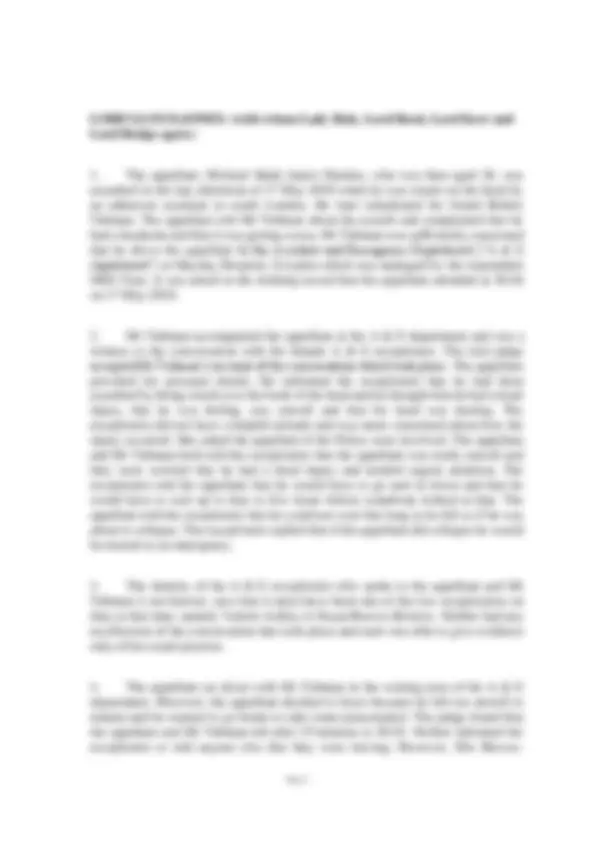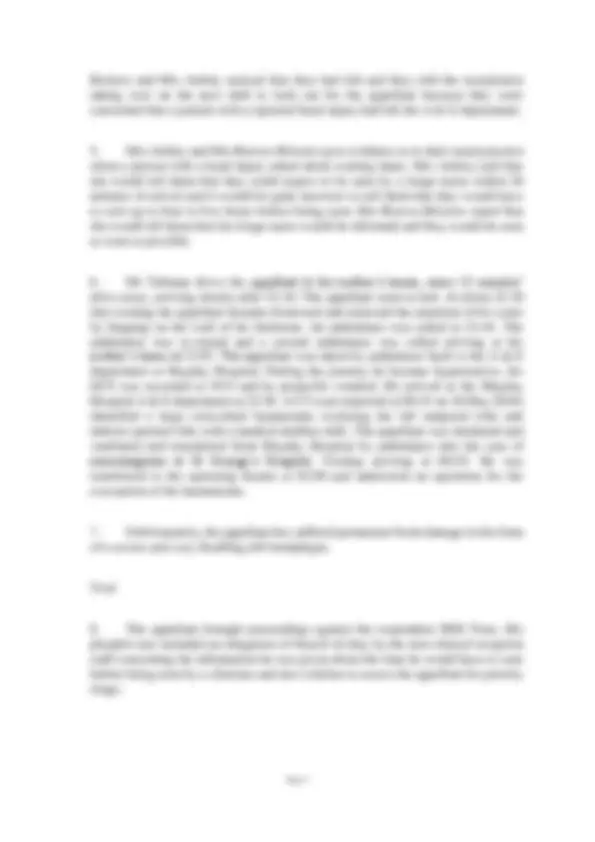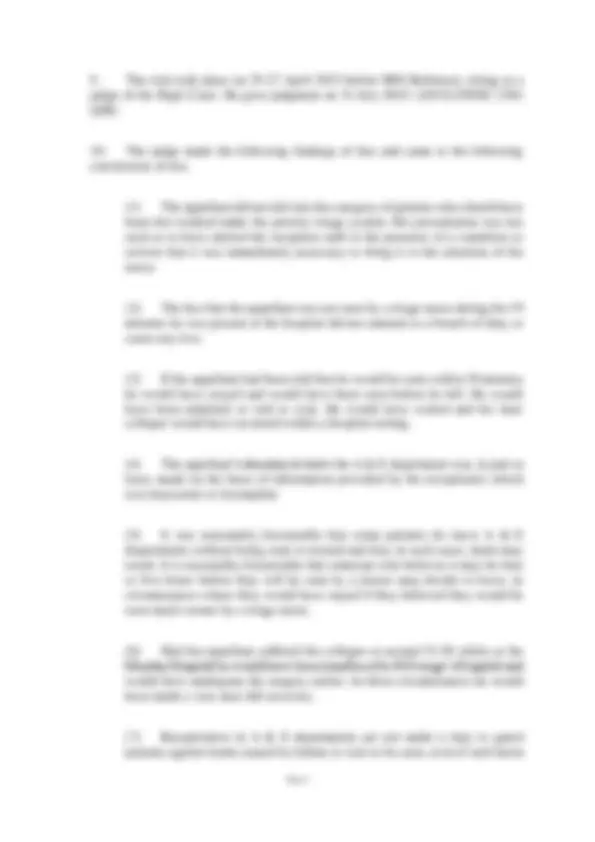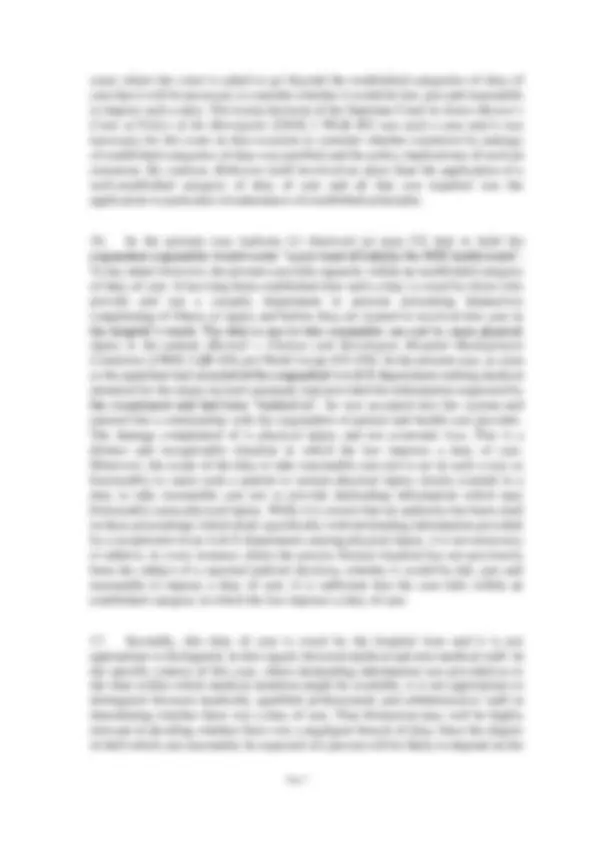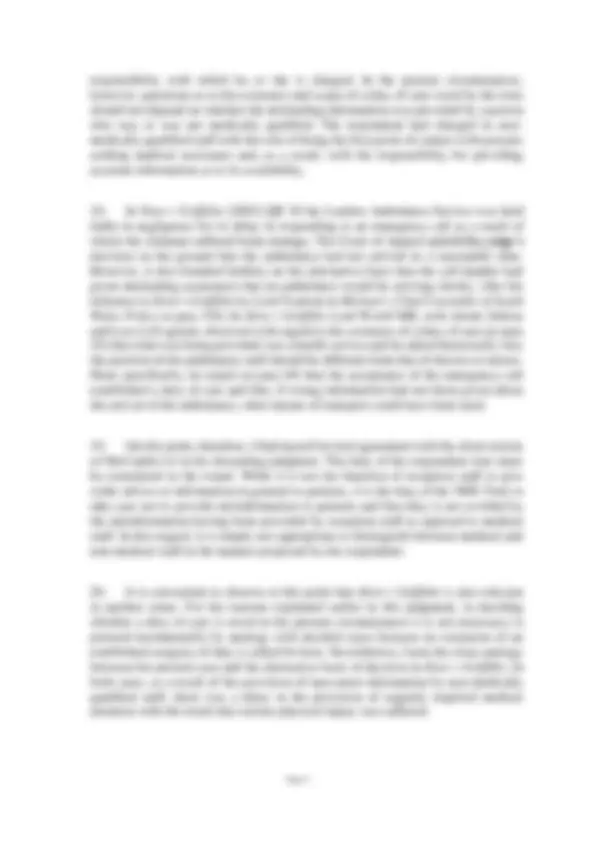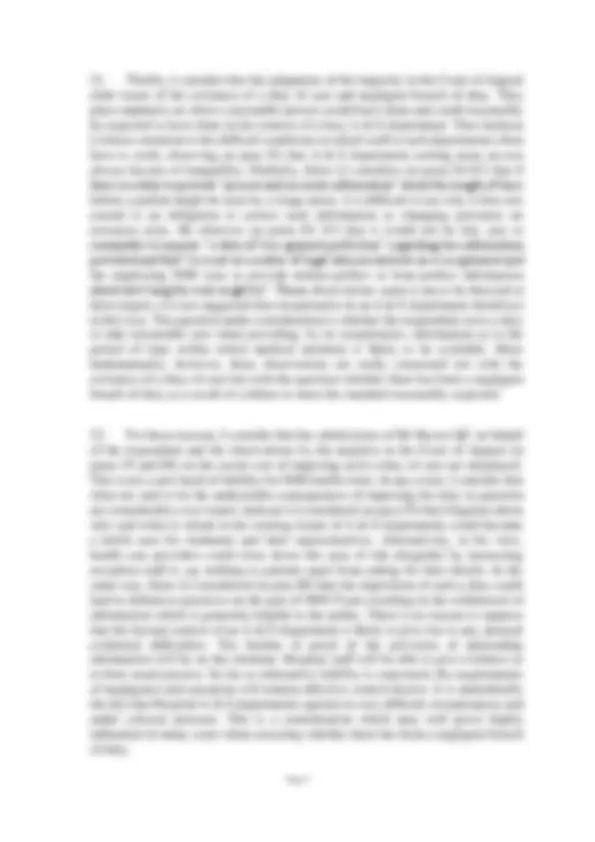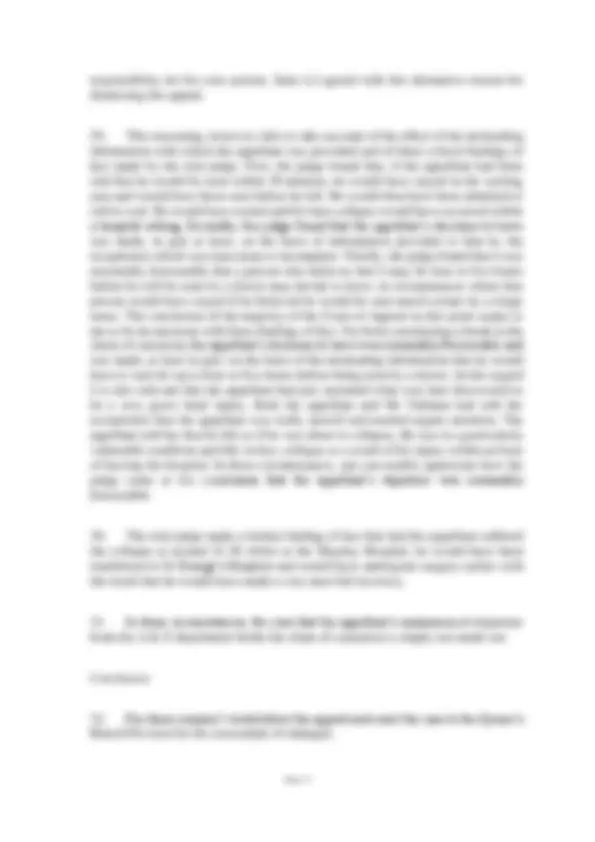Download Duty of Care towards Patients: Misleading Information by Receptionists in A&E Departments and more Study notes Acting in PDF only on Docsity!
Michaelmas Term [2018] UKSC 50 On appeal from: [2017] EWCA Civ 151
JUDGMENT
Darnley (Appellant) v Croydon Health Services
NHS Trust (Respondent)
before
Lady Hale, President
Lord Reed, Deputy President
Lord Kerr
Lord Hodge
Lord Lloyd-Jones
JUDGMENT GIVEN ON
10 October 2018
Heard on 7 June 2018
Appellant Respondent Simeon Maskrey QC Philip Havers QC Jeremy Pendlebury Bradley Martin QC Ruth Kennedy (Instructed by Russell- Cooke LLP) (Instructed by Capsticks Solicitors)
Bristow and Mrs Ashley noticed that they had left and they told the receptionist taking over on the next shift to look out for the appellant because they were concerned that a patient with a reported head injury had left the A & E department.
- Mrs Ashley and Mrs Reeves-Bristow gave evidence as to their usual practice when a person with a head injury asked about waiting times. Mrs Ashley said that she would tell them that they could expect to be seen by a triage nurse within 30 minutes of arrival and it would be quite incorrect to tell them that they would have to wait up to four to five hours before being seen. Mrs Reeves-Bristow stated that she would tell them that the triage nurse would be informed and they would be seen as soon as possible.
- Mr Tubman drove the appellant to his mother’s house, some 13 minutes’ drive away, arriving shortly after 21:10. The appellant went to bed. At about 21: that evening the appellant became distressed and attracted the attention of his sister by banging on the wall of his bedroom. An ambulance was called at 21:44. The ambulance was re-routed and a second ambulance was called arriving at his mother’s home at 22:05. The appellant was taken by ambulance back to the A & E department at Mayday Hospital. During the journey he became hypertensive, his GCS was recorded as 9/15 and he projectile vomited. He arrived at the Mayday Hospital A & E department at 22:38. A CT scan (reported at 00:15 on 18 May 2010) identified a large extra-dural haematoma overlying the left temporal lobe and inferior parietal lobe with a marked midline shift. The appellant was intubated and ventilated and transferred from Mayday Hospital by ambulance into the care of neurosurgeons at St George’s Hospital, Tooting arriving at 00:55. He was transferred to the operating theatre at 01:00 and underwent an operation for the evacuation of the haematoma.
- Unfortunately, the appellant has suffered permanent brain damage in the form of a severe and very disabling left hemiplegia. Trial
- The appellant brought proceedings against the respondent NHS Trust. His pleaded case included an allegation of breach of duty by the non-clinical reception staff concerning the information he was given about the time he would have to wait before being seen by a clinician and also a failure to assess the appellant for priority triage.
- The trial took place on 25-27 April 2015 before HHJ Robinson, sitting as a judge of the High Court. He gave judgment on 31 July 2015: [2015] EWHC 2301 (QB).
- The judge made the following findings of fact and came to the following conclusions of law. (1) The appellant did not fall into the category of patients who should have been fast tracked under the priority triage system. His presentation was not such as to have alerted the reception staff to the presence of a condition so serious that it was immediately necessary to bring it to the attention of the nurse. (2) The fact that the appellant was not seen by a triage nurse during the 19 minutes he was present at the hospital did not amount to a breach of duty or cause any loss. (3) If the appellant had been told that he would be seen within 30 minutes he would have stayed and would have been seen before he left. He would have been admitted or told to wait. He would have waited and his later collapse would have occurred within a hospital setting. (4) The appellant’s decision to leave the A & E department was, in part at least, made on the basis of information provided by the receptionist which was inaccurate or incomplete. (5) It was reasonably foreseeable that some patients do leave A & E departments without being seen or treated and that, in such cases, harm may result. It is reasonably foreseeable that someone who believes it may be four or five hours before they will be seen by a doctor may decide to leave, in circumstances where they would have stayed if they believed they would be seen much sooner by a triage nurse. (6) Had the appellant suffered the collapse at around 21:30 whilst at the Mayday Hospital he would have been transferred to St George’s Hospital and would have undergone the surgery earlier. In those circumstances he would have made a very near full recovery. (7) Receptionists in A & E departments are not under a duty to guard patients against harm caused by failure to wait to be seen, even if such harm
consequences which would follow if such a duty of care were imposed (at paras 55, 84, 87, 88).
- In his dissenting judgment, McCombe LJ considered that, on the particular facts found by the judge, the respondent was in breach of a duty of care owed to the appellant. The information provided could only have given the false impression that the appellant would not be seen or assessed by anyone sooner than the indicated period of up to four or five hours, short of something like a collapse (at para 68). Moreover, he rejected the suggestion that the functions of a hospital can be divided into those of receptionists and those of medical staff; it is the duty of the hospital not to provide misinformation to patients, whether it is provided by reception staff or medical staff (at para 71). Incomplete and inaccurate information had been provided negligently. The failure to impart the reality of the triage system to the appellant on his arrival was, on the facts of this case, a breach of duty by the hospital (at para 77). Furthermore, that breach of duty was causative of the appellant’s injury (at para 79). Duty of care
- I consider that the approach of the majority in the Court of Appeal to the issue of duty of care is flawed in a number of respects.
- First, we are not here concerned with the imposition of a duty of care in a novel situation. The common law in this jurisdiction has abandoned the search for a general principle capable of providing a practical test applicable in every situation in order to determine whether a duty of care is owed and, if so, what is its scope. ( Caparo Industries plc v Dickman [1990] 2 AC 605 per Lord Bridge at p 617; Michael v Chief Constable of South Wales Police (Refuge intervening) [2015] AC 1732 per Lord Toulson at para 106; Robinson v Chief Constable of West Yorkshire Police [2018] 2 WLR 595 per Lord Reed at para 24). In the absence of such a universal touchstone, it has taken as a starting point established categories of specific situations where a duty of care is recognised and it has been willing to move beyond those situations on an incremental basis, accepting or rejecting a duty of care in novel situations by analogy with established categories ( Caparo per Lord Bridge at p 618 citing Brennan J in the High Court of Australia in Sutherland Shire Council v Heyman (1985) 60 ALR 1, at pp 43- 4 4). The familiar statement of principle by Lord Bridge in Caparo at pp 617 - 618 in which he refers to the ingredients of foreseeability of damage, proximity and fairness does not require a re-evaluation of whether those criteria are satisfied on every occasion on which an established category of duty is applied. In particular, as Lord Reed demonstrated in his judgment in Robinson (at paras 26, 27), where the existence of a duty of care has previously been established, a consideration of justice and reasonableness has already been taken into account in arriving at the relevant principles and it is, normally, only in
cases where the court is asked to go beyond the established categories of duty of care that it will be necessary to consider whether it would be fair, just and reasonable to impose such a duty. The recent decision of the Supreme Court in James-Bowen v Comr of Police of the Metropolis [2018] 1 WLR 402 was such a case and it was necessary for the court on that occasion to consider whether extension by analogy of established categories of duty was justified and the policy implications of such an extension. By contrast, Robinson itself involved no more than the application of a well-established category of duty of care and all that was required was the application to particular circumstances of established principles.
- In the present case Jackson LJ observed (at para 53) that to hold the respondent responsible would create “a new head of liability for NHS health trusts”. To my mind, however, the present case falls squarely within an established category of duty of care. It has long been established that such a duty is owed by those who provide and run a casualty department to persons presenting themselves complaining of illness or injury and before they are treated or received into care in the hospital’s wards. The duty is one to take reasonable care not to cause physical injury to the patient ( Barnett v Chelsea and Kensington Hospital Management Committee [1969] 1 QB 428, per Nield J at pp 435 - 43 6). In the present case, as soon as the appellant had attended at the respondent’s A & E department seeking medical attention for the injury he had sustained, had provided the information requested by the receptionist and had been “booked in”, he was accepted into the system and entered into a relationship with the respondent of patient and health care provider. The damage complained of is physical injury and not economic loss. This is a distinct and recognisable situation in which the law imposes a duty of care. Moreover, the scope of the duty to take reasonable care not to act in such a way as foreseeably to cause such a patient to sustain physical injury clearly extends to a duty to take reasonable care not to provide misleading information which may foreseeably cause physical injury. While it is correct that no authority has been cited in these proceedings which deals specifically with misleading information provided by a receptionist in an A & E department causing physical injury, it is not necessary to address, in every instance where the precise factual situation has not previously been the subject of a reported judicial decision, whether it would be fair, just and reasonable to impose a duty of care. It is sufficient that the case falls within an established category in which the law imposes a duty of care.
- Secondly, this duty of care is owed by the hospital trust and it is not appropriate to distinguish, in this regard, between medical and non-medical staff. In the specific context of this case, where misleading information was provided as to the time within which medical attention might be available, it is not appropriate to distinguish between medically qualified professionals and administrative staff in determining whether there was a duty of care. That distinction may well be highly relevant in deciding whether there was a negligent breach of duty; there the degree of skill which can reasonably be expected of a person will be likely to depend on the
- Thirdly, I consider that the judgments of the majority in the Court of Appeal elide issues of the existence of a duty of care and negligent breach of duty. They place emphasis on what a reasonable person would have done and could reasonably be expected to have done in the context of a busy A & E department. Thus Jackson LJ draws attention to the difficult conditions in which staff at such departments often have to work, observing (at para 54) that A & E department waiting areas are not always havens of tranquillity. Similarly, Sales LJ considers (at paras 84- 8 7) that if there is a duty to provide “precise and accurate information” about the length of time before a patient might be seen by a triage nurse, it is difficult to see why it does not extend to an obligation to correct such information as changing pressures on resources arise. He observes (at paras 85, 87) that it would not be fair, just or reasonable to impose “a duty of fine-grained perfection” regarding the information provided and that “it is not as a matter of legal duty incumbent on a receptionist and the employing NHS trust to provide minute-perfect or hour-perfect information about how long the wait might be”. These observations seem to me to be directed at false targets; it is not suggested that receptionists in an A & E department should act in this way. The question under consideration is whether the respondent owes a duty to take reasonable care when providing, by its receptionists, information as to the period of time within which medical attention is likely to be available. More fundamentally, however, these observations are really concerned not with the existence of a duty of care but with the question whether there has been a negligent breach of duty as a result of a failure to meet the standard reasonably expected.
- For these reasons, I consider that the submissions of Mr Havers QC on behalf of the respondent and the observations by the majority in the Court of Appeal (at paras 55 and 88) on the social cost of imposing such a duty of care are misplaced. This is not a new head of liability for NHS health trusts. In any event, I consider that what are said to be the undesirable consequences of imposing the duty in question are considerably over-stated. Jackson LJ considered (at para 55) that litigation about who said what to whom in the waiting rooms of A & E departments could become a fertile area for claimants and their representatives. Alternatively, in his view, health care providers could close down this area of risk altogether by instructing reception staff to say nothing to patients apart from asking for their details. In the same way, Sales LJ considered (at para 88) that the imposition of such a duty could lead to defensive practices on the part of NHS Trusts resulting in the withdrawal of information which is generally helpful to the public. There is no reason to suppose that the factual context of an A & E department is likely to give rise to any unusual evidential difficulties. The burden of proof of the provision of misleading information will be on the claimant. Hospital staff will be able to give evidence as to their usual practice. So far as substantive liability is concerned, the requirements of negligence and causation will remain effective control factors. It is undoubtedly the fact that Hospital A & E departments operate in very difficult circumstances and under colossal pressure. This is a consideration which may well prove highly influential in many cases when assessing whether there has been a negligent breach of duty.
- Finally in this regard, I should record that in considering the issue of duty of care I have been greatly assisted by a case note on the decision of the Court of Appeal in the present case by Professor James Goudkamp ([2017] CLJ 481). He considers that the parties were within an established duty category and that the only question, relevantly, was whether the defendant breached that duty. He observes that discussion as to what the reasonable person would have done in the circumstances in question indicates that the dispute is about the breach element, that being the only element of the cause of action in negligence that is concerned with the satisfactoriness of the defendant’s conduct. He concludes: “Accordingly, on traditional principles, Darnley is not, in fact, a duty of care case at all. Rather, properly understood, the issue was whether the defendant had breached its duty in giving, by its receptionist, inaccurate information to the claimant.” (at p
I agree with his analysis. It is to that question of negligent breach of duty that I now turn. Negligent breach of duty
- The reception desk at the A & E department was the first point of contact between the respondent trust and members of the public seeking medical assistance. It has not been suggested that the respondent was in any way at fault in allocating this responsibility to receptionists who were not medically qualified. Moreover, it has not been suggested that the receptionists should have provided accurate information to each patient on arrival as to precisely when he or she would be seen by a medically qualified member of staff. Anyone who has any experience of A & E departments will know that this would be impossible. The pressures on medical staff are enormous, the demand for attention is constantly fluctuating and priorities are likely to change. However, it is not unreasonable to require receptionists to take reasonable care not to provide misleading information as to the likely availability of medical assistance.
- The particular role performed by the individual concerned will be likely to have an important bearing on the question of breach of the duty of care. As Mustill LJ explained in Wilsher v Essex Area Health Authority [1987] QB 730, 750 - 75 1, the legitimate expectation of the patient is that he will receive from each person concerned with his care a degree of skill appropriate to the task which he or she undertakes. A receptionist in an A & E department cannot, of course, be expected to give medical advice or information but he or she can be expected to take reasonable care not to provide misleading advice as to the availability of medical assistance.
responsibility for his own actions. Sales LJ agreed with this alternative reason for dismissing the appeal.
- This reasoning, however, fails to take account of the effect of the misleading information with which the appellant was provided and of three critical findings of fact made by the trial judge. First, the judge found that, if the appellant had been told that he would be seen within 30 minutes, he would have stayed in the waiting area and would have been seen before he left. He would then have been admitted or told to wait. He would have waited and his later collapse would have occurred within a hospital setting. Secondly, the judge found that the appellant’s decision to leave was made, in part at least, on the basis of information provided to him by the receptionist which was inaccurate or incomplete. Thirdly, the judge found that it was reasonably foreseeable that a person who believes that it may be four or five hours before he will be seen by a doctor may decide to leave, in circumstances where that person would have stayed if he believed he would be seen much sooner by a triage nurse. The conclusion of the majority of the Court of Appeal on this point seems to me to be inconsistent with these findings of fact. Far from constituting a break in the chain of causation, the appellant’s decision to leave was reasonably foreseeable and was made, at least in part, on the basis of the misleading information that he would have to wait for up to four or five hours before being seen by a doctor. In this regard it is also relevant that the appellant had just sustained what was later discovered to be a very grave head injury. Both the appellant and Mr Tubman had told the receptionist that the appellant was really unwell and needed urgent attention. The appellant told her that he felt as if he was about to collapse. He was in a particularly vulnerable condition and did, in fact, collapse as a result of his injury within an hour of leaving the hospital. In these circumstances, one can readily appreciate how the judge came to his conclusion that the appellant’s departure was reasonably foreseeable.
- The trial judge made a further finding of fact that had the appellant suffered the collapse at around 21:30 whilst at the Mayday Hospital, he would have been transferred to St George’s Hospital and would have undergone surgery earlier with the result that he would have made a very near full recovery.
- In these circumstances, the case that the appellant’s unannounced departure from the A & E department broke the chain of causation is simply not made out. Conclusion
- For these reasons I would allow the appeal and remit the case to the Queen’s Bench Division for the assessment of damages.
- Finally, the court would like to express its appreciation of the clarity and economy of the written and oral submissions of both parties in this case. They were a model of what can be achieved and without any loss of depth or substance.

